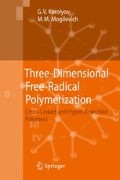Abstract
Chapter 8 does not presume to describe a variety of hyper-branched polymer (HBP) properties and examples of HBP application. This chapter is based on those studies and publications in which an interrelationship between the unique HBP properties and morphology and topology of HBP structure has been revealed. Special attention is given to industrially produced HBP—Boltorn® and Hybrane®. Problems to be solved in the near future have been formulated—theoretical problems plus analytical and synthetic concerns. Finding solutions to these problems would move us closer to the practical application of HBP. The progress associated with HBP application is so significant that one has grounds to assert that a revolution has occurred in polymeric material science.
As has been indicated earlier (Chap. 7), hyper-branched polymers (HBP) possess unique properties distinguishing them from polymers belonging to other classes. The unusual topological structure, the “core-shell” characterized by a very high local concentration of chain ends in the peripheral layer (shell) of macromolecules and a very high local concentration of branching points in the core, represents a source of these unique properties. As a result, the hydrodynamic volume of HBP macromolecules stops increasing after a certain degree of branching has been reached and, starting from a certain value Mn (usually starting from Mn > 104), the volume becomes significantly less than the hydrodynamic volume of linear macromolecules with the same value Mn. Such compact packing of HBP macromolecules and the large number of free chain ends at the periphery represent the primary structural and physical reasons for the manifestation of the unique HBP properties.
At the macroscopic level, the topological features of HBP are manifested as properties such as high solubility and thermodynamic compatibility, and high sorption capacity in combination with the ability to transport sorbates in those media in which the sorbate is insoluble (this ability allows using HBP as Ners with a high local concentration of reagents). All these properties appeared to be in demand in polymer material science, in medicine, in biology, in electronics, and in other fields of application. It should be pointed out that the HBP application efficiency was so high (improvement in properties by 100–200%!) that it led to a revolution in polymer material science.
Access this chapter
Tax calculation will be finalised at checkout
Purchases are for personal use only
Preview
Unable to display preview. Download preview PDF.
References
Korolev GV, Bubnova ML (2007) Vysokomolek Soedin A 49:1357–1388 (in Russian)
Properties and applications of BoltornˆledR (2001) In: Pettersson B (ed) Dendritic polymers. Perstorp Speciality Chemicals AB, SE-284 80 Perstorp, Sweden. BoltornˆledR: Advancing performance & comfort. Perstorp Corp. http://www.perstorp.com/upload/boltorn_002.pdf. Accessed 22 June 2008.
Hybrane, DCM’s hyperbranched polymer platform. DCM Corp. http://www.dsm.com/en US/downloads/hybrane/hybrane molecule.pdf. Accessed 22 June 2008
Ratna D, Varley R, Singh Raman RK, Siman GP (2003) J Mater Sci 38:147–154
Ratna D, Siman GP (2001) Polymer 42:8833–8839
Ratna D, Varley R, Siman GP (2003) J Appl Polym Sci 89:2339–2345
Flohlich J, Kautz, Thoman R et al (2004) Polymer 45:2155–2164
Bergbreiter DE, Boren D, Kippenberger AM (2004) Macromolecules 37:8686–8691
Xu G, Shi WF, Gong M et al (2004) Eur Polym J 40:483–491
Ratna D, Becker O, Krishnamurthy R et al (2003) Polymer 44:7449–7457
Rodlert M, Plummer CJG, Garamszegi L et al (2004) Polymer 45:949–960
Granick S, Kumar SK, Amis EJ et al (2003) J Polym Sci Polym Phys 41:2755–2793
Seiler M (2002) Chem Eng Technol 25:237–253
Voit B, Beyerlein D, Eichhorn KJ et al (2002) Chem Eng Technol 25:704–707
Hong CY, You YZ, Decheng WU et al (2005) Macromolecules 38:2606–2611
Crooks RM (2001) Chem Phys Chem 2:644–654
Kou HG, Shi WF (2004) Eur Polym J 40:1337–1342
Dzunuzovic E, Tasic S, Bozic B et al (2005) Prog Org Coat 52:136–143
Hu G, Shi WF (2005) Prog Org Coat 52:110–111
Kong H, Luo P, Gao C et al (2005) Polymer 46:2472–2485
Zou JH, Zhao YB, Shi WF et al (2005) Polym Adv Technol 16:55–60
Abd-El-Aziz AS (2002) Macromol Rapid Commun 23:995–1031
Gao F, Schricker SR, Tong YH et al (2002) J Macromol Sci Pure Appl Chem 39:267–286
Kou HG, Asif A, Shi WF et al (2004) Polym Adv Technol 15:192–196
Albertsson A-C (ed) (2002) Adv Polym Sci 157:1–179
Siriba S, Frey H, Haag R (2002) Angew Chem Int Ed 41:1329–1334
Kang SH, Luo JD, Ma H et al (2003) Macromolecules 36:4355–4359
Siergers C, Biesalski M, Haag R (2004) J Chem Eur 10:2831–2838
Jesberger M, Barner L, Stenzel MH et al (2003) J Polym Sci Polym Chem 41:3847–3861
Kaanumalle LS, Gibb CLD, Gibb BC, Ramamurthy V (2004) J Am Chem Soc Commun 126:14366–14367
Tomalia DA (2005) Progr Polym Sci 30:294–324
Teertstra SJ, Gauthier M (2004) Progr Polym Sci 29:277–327
Thompson CH, Hu J, Kaganove SN et al (2004) Chem Mater 16:5357–5364
Belge G, Beyerlein D, Betsch C et al (2002) Anal Bioanal Chem 374:403–411
Author information
Authors and Affiliations
Rights and permissions
Copyright information
© 2009 Springer-Verlag Berlin Heidelberg
About this chapter
Cite this chapter
Korolev, G.V., Mogilevich, M.M. (2009). Properties and Application of Hyper-Branched Polymers. In: Three-Dimensional Free-Radical Polymerization. Springer, Berlin, Heidelberg. https://doi.org/10.1007/978-3-540-87567-3_8
Download citation
DOI: https://doi.org/10.1007/978-3-540-87567-3_8
Publisher Name: Springer, Berlin, Heidelberg
Print ISBN: 978-3-540-87566-6
Online ISBN: 978-3-540-87567-3
eBook Packages: Chemistry and Materials ScienceChemistry and Material Science (R0)

